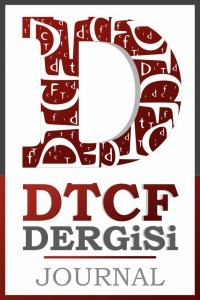İLKOKUL, ORTAOKUL VE LİSE ÖĞRENCİLERİNDE ULAMSAL ÖRGÜTLEME ÇERÇEVESİNDE TAKSONOMİK FARKINDALIK
Ulamların zihinde anlamsal ilişki ağları oluşturarak konumlandığı görüşü yaygın olarak benimsenmektedir. Bu ilişki ağları tür, bütün-parça, uzamsal konum, işlev, uzak çağrışımlar gibi pek çok ilişki tipi içermektedir. Markman bu ilişkileri 'taksonomik' ve 'tematik' ilişkiler olarak iki genel sınıfa ayırır ve 6-7 yaşına kadar çocukların çoğunlukla tematik ilişkiler kurmaya eğilimli olduğunu ancak bu yaşlardan sonra, ulamlar arası taksonomik ilişki örgütleme becerisinin ağırlık kazanmaya başladığını öne sürer. Bu çalışmada, toplam 300 ilkokul, ortaokul ve lise öğrencisinden oluşan bir araştırma grubu, verilen üç ulamsal ağdan seçtikleri ÜST, TEMEL ve ALT ulamlaştırma düzeylerine ait ulamları kullanarak belirledikleri bağlamlarda tümceler üretmiştir. Bu yolla elde edilen veritabanında, katılımcıların taksonomik ve tematik ilişkilendirme ve ulamsal düzeyleri kullanma eğilim ve becerileri gözlemlenmiştir. Sonuçlar, tematik örgütlemenin, üretilen tümcelerde net bir biçimde baskın olduğunu, taksonomik farkındalığın ise yaşa koşut biçimde arttığını göstermiştir. İki örgütleme türünde de katılımcıların ulamsal düzeylerden farklı biçimlerde yararlandıkları görülmüştür.
Anahtar Kelimeler:
Dilbilim, Anlambilim, Ruhdilbilim, Ulam, Ulamlaştırma, Ulamsal Düzeyler, Edinim, Zihin, Taksonomi
TAXONOMIC AWARENESS IN PRIMARY, SECONDARY AND HIGH SCHOOL STUDENTS WITHIN THE FRAME OF CATEGORICAL ORGANIZATION
It is widely adopted that categories reside in the mind forming webs of semantic relationships of various types. Markman classies these relationships into two broad groups: taxonomic and thematic. She claims that until the age of 6 or 7, children are more likely to form thematic relations between categories, but after this age taxonomic relations begin to gain salience. In this research, a study group consisting of 300 primary, secondary and high school students in total were given three semantic webs including categories from different levels of categorization at superordinate, basic, subordinate levels. Using the categorical levels they had chosen from the three categorical levels of the web, the participants were asked to write sentences, in the context they created. In the database, the tendency of the participants to establish thematic and taxonomic relationships as well as the categorical levels they used were observed. The results showed that taxonomic relations clearly predominated the sentences produced by the participants. However, taxonomic awareness was seen to increase with age. It was also seen that the participants used peculiar sets of categorical levels while making taxonomic and thematic sentences.
Keywords:
Linguistics, Semantics, Psycholinguistics, Category, Categorization, Categorical Levels, Acquisition, Cognition, Taxonomies,
___
- Büyüköztürk, Şener ve diğerleri. Bilimsel Araştırma Yöntemleri. Ankara: Pegem, 2012.
- Collins, Allan M. ve Elizabeth F. Loftus. “A Spreading Activation Theory of Semantic Processing.” Psychological Review (1975): 407-428
- Dirven, René ve Marjolijn Verspoor. Cognitive Exploration of Language And Linguistics. Amsterdam: John Benjamins, 2004.
- Gelman, Susan A., Sharon A. Wilcox ve Eve V. Clark. "Conceptual Hierarchies in Young Children." Cognitive Development 4 (1989): 309-326.
- Lakoff, George. Women, Fire, and Dangerous Things: What Categories Reveal About the Mind. Chicago: University of Chicago Press, 1987.
- Langacker, Ronald W. Foundations of Cognitive Grammar I. Indiana: Indiana University Linguistic Club, 1983.
- --. Foundations of Cognitive Grammar II. Stanford: Stanford University Press, 1991.
- Löbner, Sebastian. Understanding Semantics. New York: Arnold, 2002.
- Markman, Ellen M. Categorization and Naming in Children. Cambridge: MIT Press, 1991.
- Mervis, Carolyn B. ve Maria A Crisafi. ”Order of Acquisition of Subordinate, Basic and Superordinate Level Categories.” Child Development 53.1 (1982): 258- 266.
- Mervis, Carolyn B. ve Eleanor Rosch. “Categorization of Natural Objects.” Annual Review of Psychology 32 (1981): 89-115.
- Morris, Michael W. ve Gregory L. Murphy. “Converging Operations on A Basic Level in Event Taxonomies.” Memory and Cognition 18.4 (1990): 407-418
- Önal,Özay. 2, 4, 6 ve 8. sınıf Öğrencilerinde Ulamlaştırma Beceri ve Eğilimlerinin Gelişimi. Yayımlanmamış Doktora Tezi. Ankara Üniversitesi Sosyal Bilimler Enstitüsü, 2016.
- Rosch, Eleanor. “Principles of Categorization.” Concept:Core Readings. Eds. Eric Laurance ve Stephen Margolis. Cambridge, MA: MIT Press,1999. 189-206.
- Rosch, Eleanor ve diğerleri. “Basic Objects in Natural Categories.” Cognitive Psychology 8 (1976): 382-439.
- Schmid, Hans-Jörg. “Entrenchment, Salience, and Basic Levels.” The Oxford Handbook of Cognitive Linguisitcs. Eds. Dirk Geeraerts ve Hubert Cuyckens. Oxford: Oxford University, 2007. 117-138.
- Shanks, David R. “Representation of Categories and Concepts.” Cognitive Models of Memory Ed. Martin A.Conway. Cambridge: MIT Press, 1997. 111-146.
- Taylor, John R. Cognitive Grammar. Oxford: Oxford University Press. 2003.
- Ungerer, Friedrich ve Hans-Jörg Schmid. An Introduction to Cognitive Linguistics. Harlow: Pearson Longman, 2006.
- Waxman, Sandra ve Thomas Hatch. "Beyond the Basics: Preschool Children Label Objects Flexibly at Hierarchical Levels." Child Language 19.1 (1992):153-166.
- Yayın Aralığı: Yılda 2 Sayı
- Başlangıç: 1942
- Yayıncı: Ankara Üniversitesi
Sayıdaki Diğer Makaleler
GIOVANNI PAPINI'NİN BİTİK ADAM ADLI YAPITINDA PRAGMATİZME BAKIŞ
OSMANLI DÖNEMİ'NDE KULLANILAN İKİ ANALOG BİLGİSAYAR: RUBÛ' EL-MÜCEYYEB VE PERGÂR-I NİSBE
ANNEMİN OTOBİYOGRAFİSİ: POST/KOLONYAL TRAVMAYA ULAŞMA YOLU OLARAK ANLATI
EGE BÖLGESİ'NDE NEANDERTAL İNSANIN İZLERİ
SELÇUKLU DEVLETİNİN YADİGÂRI CELALİ KALESİ
Giuseppe Tomasi Di Lampedusa ve "Il Gattopardo"da Yaşam, Ölüm ve Sonsuzluk Arzusu
ULUSAL STRATEJİLER ÇERÇEVESİNDE BİRLİKTE ÇALIŞABİLİRLİK EYLEMLERİNİN DEĞERLENDİRİLMESİ
Saime Özlem GÖKKURT, Hakan DEMİRTEL
THE WEARY GENERATIONS ROMANINDA POLİTİK VE TARİHİ OLGULAR
MONARŞİ VE MODERNİTE: ÇEK MİLLİYETÇİLİĞİ VE HABSBURG İMPARATORLUĞU'NUN SON DÖNEMİ
